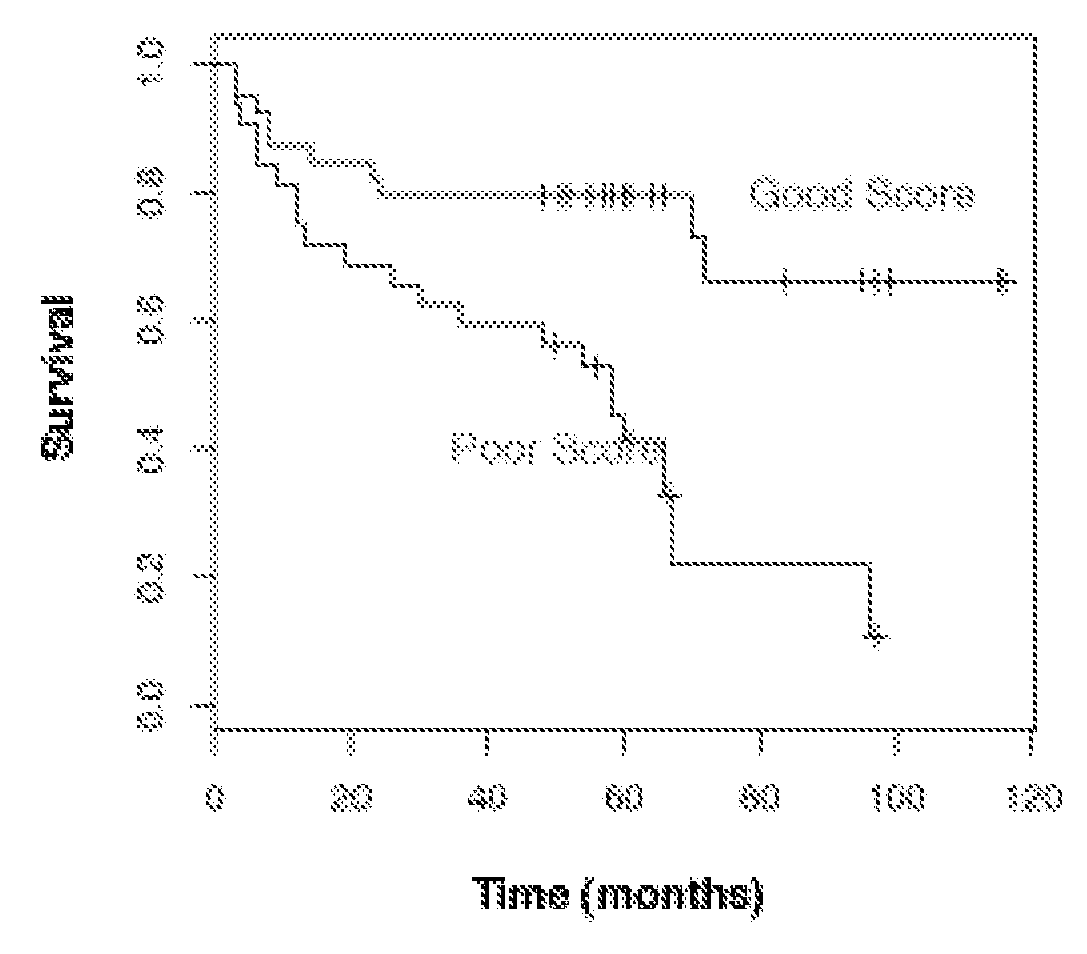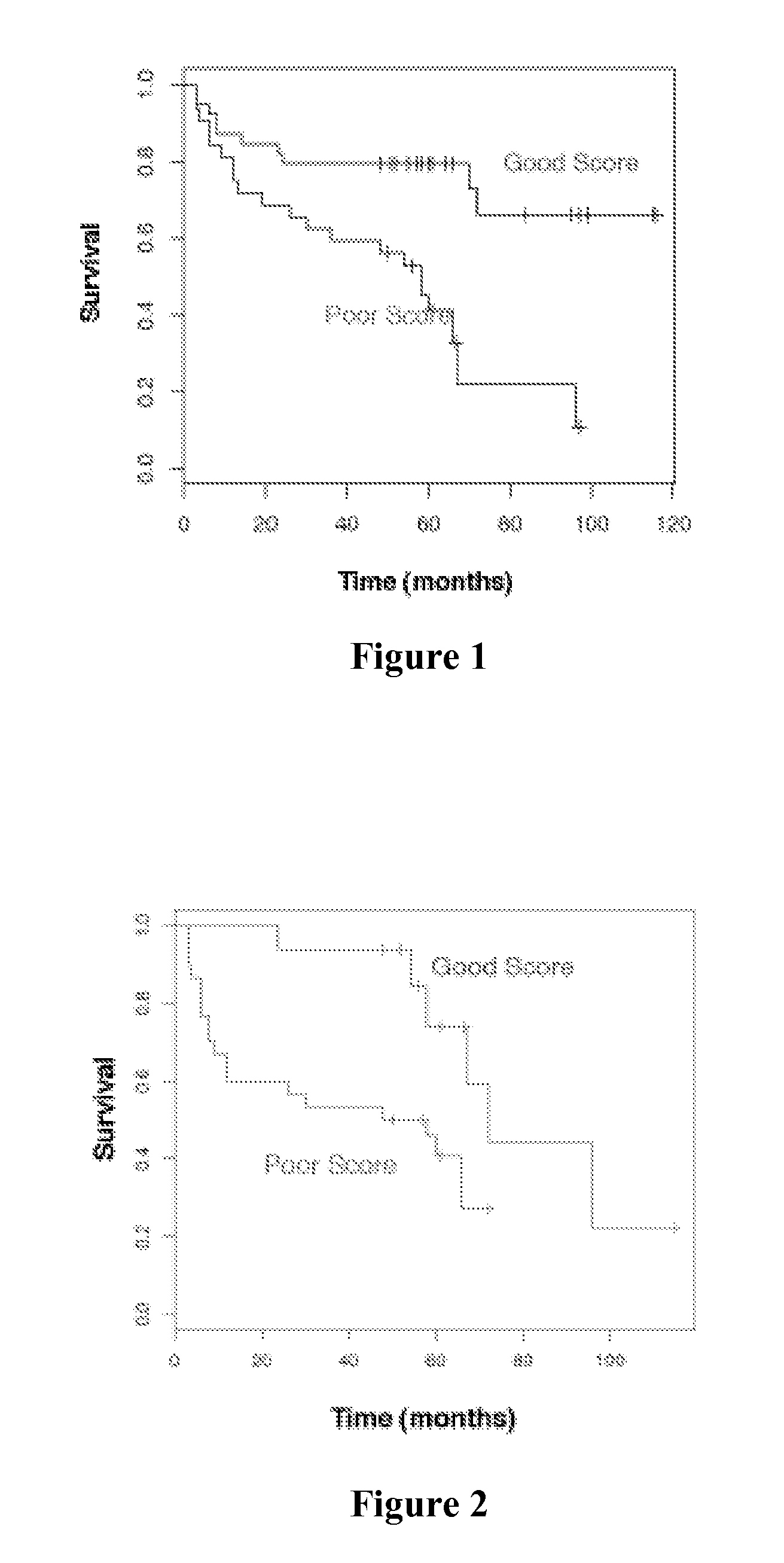Prostate cancer biomarkers to predict recurrence and metastatic potential
a prostate cancer and biomarker technology, applied in the field of prostate cancer biomarkers to predict recurrence and metastatic potential, can solve the problem of difficult to predict the outcome of patients based solely on the gleason scor
- Summary
- Abstract
- Description
- Claims
- Application Information
AI Technical Summary
Benefits of technology
Problems solved by technology
Method used
Image
Examples
example 1
Identification of Biomarker Predictors for the Progression and Metastatic Potential of Prostate Cancer
[0051]A highly predictive set of 520 genes was determined through analysis of multiple publicly available gene expression datasets (Dhanasekaran et al., Nature 412:822-6 (2001); Lapointe et al., Proc. Natl. Acad. Sci. USA 101:811-6 (2004); LaTulippe et al., Cancer Res. 62:4499-506 (2002); Varambally et al., Cancer Cell 8:393-406 (2005)), datasets from gene expression profiling analysis of 58 prostate cancer patient samples (Liu et al., Cancer Res. 66:4011-9 (2006)), and genes involved in prostate cancer progression based on state of the art understanding of the disease (Tomlins et al., Science 310:644-8 (2005); Varambally et al., Cancer Cell 8:393-406 (2005)). The predictive set of 520 genes were optimized for performance in the cDNA-mediated annealing, selection, extension, and ligation (DASL®) assay (Illumina, Inc.; San Diego, Calif.). The DASL® assay is based upon multiplexed rev...
example 2
Determination of Novel Partly Linear Accelerated Failure Time (AFT) Model
Feature Selection in AFT
[0052]The accelerated failure time (AFT) model is an important tool for the analysis of censored outcome data (Cox and Oakes, Analysis of Survival Data, Chapman and Hall, London, England (1984); Kalbfleisch and Prentice, The Statistical Analysis of Failure Tie Data, John Wiley, New York, N.Y. (2002)). Classic AFT models assume that the covariate effects on the logarithm of the time-to-event are linear, in which case standard rank-based techniques for estimation and inference could be used (Jin et al., Biometrika 90:341-53 (2003)), and its extension for lasso-type regularized variable selection could be considered (Cai et al., Biometrics, In press, 2009). Regarding these variable selection procedures, there are two unsatisfying products. First, it is assumed that the clinical effects are linear. Second, an unsupervised implementation of the regularized variable selection procedure can ina...
example 3
Simulation Studies
[0063]Multiple simulation studies were conducted to evaluate the operating characteristics of the methods in comparison with several other methods. All calculations were conducted in R and the models described herein were fit using the algorithms proposed above, which utilize the quantreg package in R.
[0064]A case of single covariate and single covariate Xi in (1) was first considered and the estimates of the regression coefficient ν and its sampling variance were focused on. Note in this setup, no feature selection was involved. To facilitate comparisons, the simulation study details were adapted from those given by Chen et al. (Chen et al., Statistica Sinica 15:767-79 (2005)). It was assumed that the partly linear model (1) holds with ν=1 and εi˜N(0, σ2) with σ2=1 and mutually independent of (Xi, Zi). The random variable Xi was correlated with Zi through the regression relation Xi=0.25 Zi+Ui, where Ui is Un(−5, 5) and completely independent of all other...
PUM
| Property | Measurement | Unit |
|---|---|---|
| PSA | aaaaa | aaaaa |
| failure time model | aaaaa | aaaaa |
| lifetime | aaaaa | aaaaa |
Abstract
Description
Claims
Application Information
 Login to View More
Login to View More - R&D
- Intellectual Property
- Life Sciences
- Materials
- Tech Scout
- Unparalleled Data Quality
- Higher Quality Content
- 60% Fewer Hallucinations
Browse by: Latest US Patents, China's latest patents, Technical Efficacy Thesaurus, Application Domain, Technology Topic, Popular Technical Reports.
© 2025 PatSnap. All rights reserved.Legal|Privacy policy|Modern Slavery Act Transparency Statement|Sitemap|About US| Contact US: help@patsnap.com



